It’s here – my thoughts on the new Canon 1DX MkII
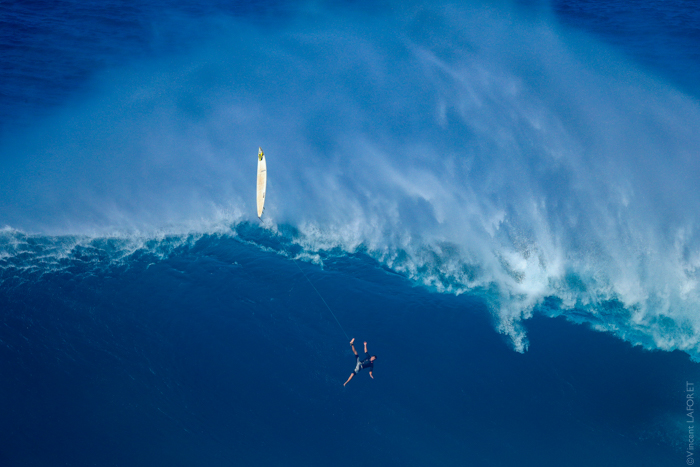
Tom Dosland at JAWS. Photo by Vincent Laforet
For the past week or so I’ve been lucky to get a chance to shoot Canon’s new flagship camera – the EOS 1DX MKII.
As many of you know, I used the previous version of this camera extensively on the AIR project in conjunction with the Canon 5Ds. I came to call the 1DX the “king of the night” for it’s incredible low light performance. It seems Canon has continued to push the envelope with this camera in that area and added quite a few significant features.
The big question these days with any camera it seems is: is this a still camera or a video camera – given the wild moves towards motion that the industry has taken over the last several years.
I’d say the 1DX MKII lives comfortably in both worlds right now.
First, with 14 frames a second and C-Fast 2.0 cards, this thing is a monster in terms of still camera capabilities. As you’ll see on this sequence of surfer Tom Dosland wiping out and falling from the lip of a 40-foot-wave at JAWS in Maui, this camera produces quite a sequence of frames on peak action.
Frankly you almost feel like you’re shooting a film with a mechanical camera at this point – and good luck trying to fill the buffer with the new speedy cards. In this case I was using the Sandisk 128GB Sandisk C-Fast 2.0 cards which were literally hot to the touch when I ejected them from the camera.
This sequence was shot with the Canon 800mm 5.6 and the AF didn’t miss a lick. My only regret is not having shot a little looser on what were what some describe as the waves of the decade at JAWS.

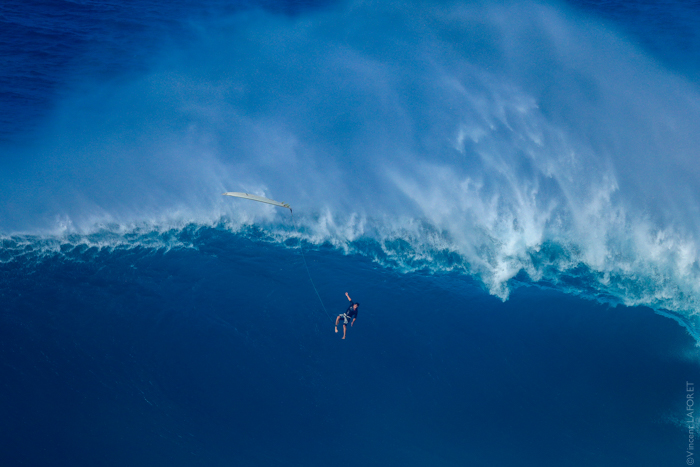
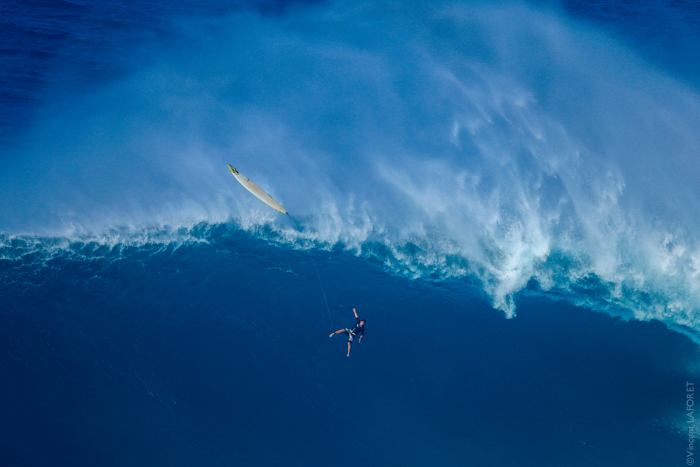
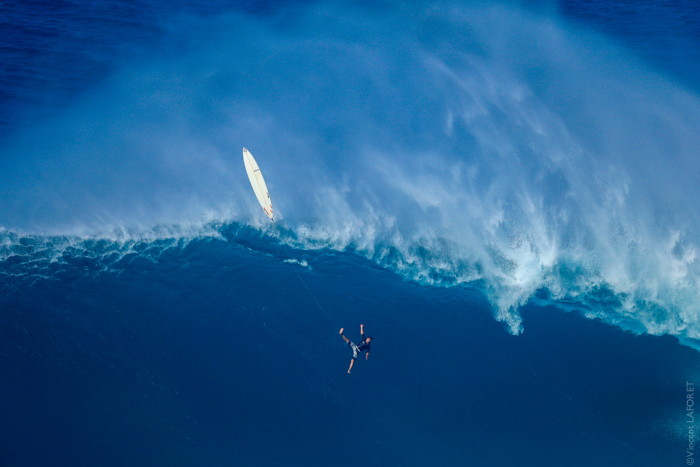

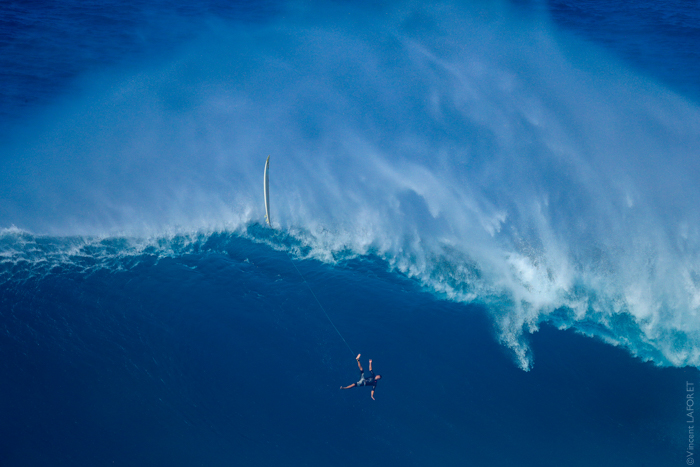

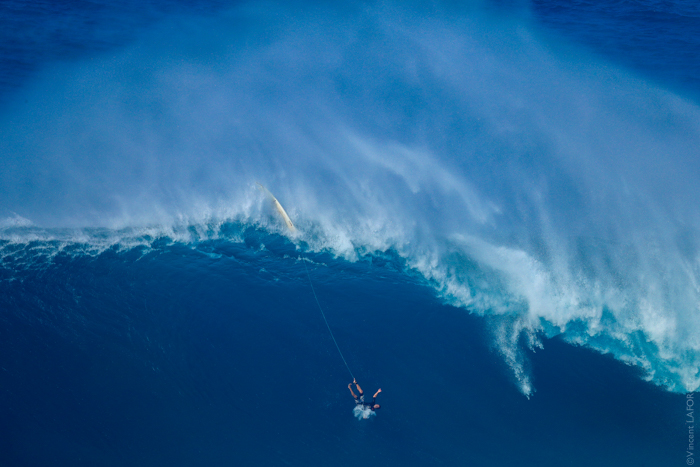
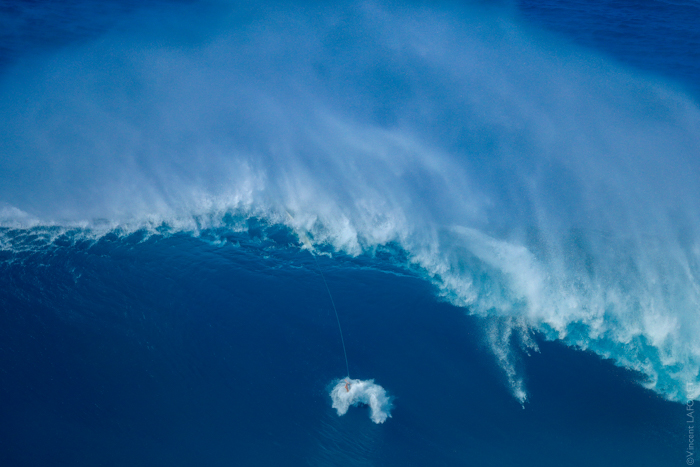
Tom Dosland at JAWS. Photo sequence by Vincent Laforet
I shot two days at Jaws and nearly 8,000 frames (I was trying to demonstrate the sequence potential of the camera for Canon so I shot unusually heavily) and of the approximately 9 hours of shooting, the AF only veered off momentarily for one sequence out of nearly a hundred. Quite impressive.
Here are a couple of additional images I shot of a diver off of South Point on the Big Island yesterday. The resolving power of this camera is incredible (looks like a groundbreaking sensor) and quite visible on the face of the rocks…
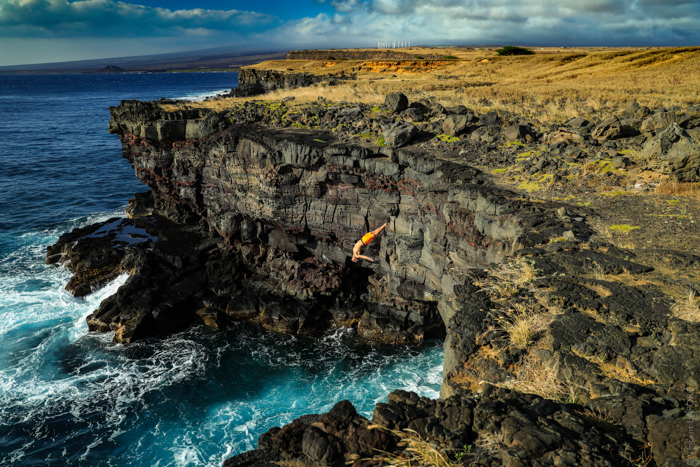
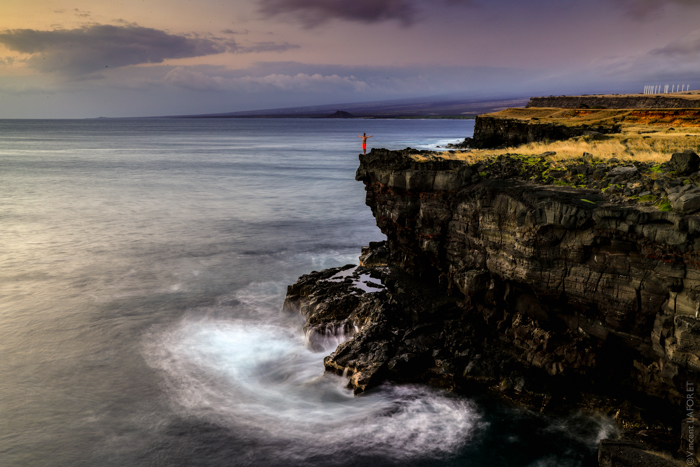
Other than the built-in GPS functionality which allows you to track your path, and of course to collect GPS data while you shoot and embed them in each still frame, the biggest surprise were 3 new video functionalities.
First, the camera has built in AF with face recognition for video and a touch screen display. And it works pretty solidly. Although surfing isn’t quite a torture test for an AF system (although it does have to be quite precise) I can’t recall a single sequence where it failed me. It just worked…
The comes the 4K video which results in nearly crystal clear video on an Apple MacBook Retina display. I’d love to see a Canon Log feature added to this camera at some point, as the dynamic range of the video is quite impressive. I’m not going to claim that it rivals that of RAW format high end cinema cameras, but for an SLR it’s quite excellent.
The two big surprises for me were that the camera shoots 60 fps at 4K (around an APS-H sensor focal length equivalent for 4K), and 120 fps at 1080p. And that’s a significant bump in frame rates – notably for a DSLR.
I expect to come back and post some video samples from Hawaii and JAWS in the coming week, but the clips are so large that I’m going to have to wait to get back to the mainland and faster internet speeds to upload them at this point.
Overall I’m extremely impressed with this camera. It’s as with all Canon 1D series bodies built like a tank and ready to be exposed to almost any series of conditions you throw it at.
The AF performance, the frame rate both still and in motion are quite impressive. And the GPS, touch screen AF, live view and customizability of functions are welcome additions to what was already the very definition of a “workhorse.”
And lastly a nice surprise was the battery performance. As is often the case with prototypes, I was only able to get one battery. With live view, constant AF on a 200-400mm, and a combination of still + mostly video shooting on the second day, the camera was able to last nearly 4 hours of use (with period shut downs to conserve battery.) That’s impressive. As a still camera I think it’s safe to assume this camera would survive heavy use for an entire day if not more – but I haven’t been able to do a formal “scientific” test.
Lastly – with the high ISO performance come exceptional results in the “middle” ISO area. During daytime and normal levels of sunlight, I found myself shooting a 800-1250 ISO and 1/4000th of a frame and f/8 on the 800mm f5.6. This is the first camera to let you shoot past f 5.6 with all AF sensors from Canon and achieve excellent AF results – but most importantly the quality of the frames at that high ISO is exceptional: they look no different to my eye to what I would have expected at 200 ISO just a few years back.
Incredibly impressive low light performance too – here’s a 50mm f1.2 at 1.6 with a 10 second exposure at 6400 ISO – shot at 12,500 feet elevation!
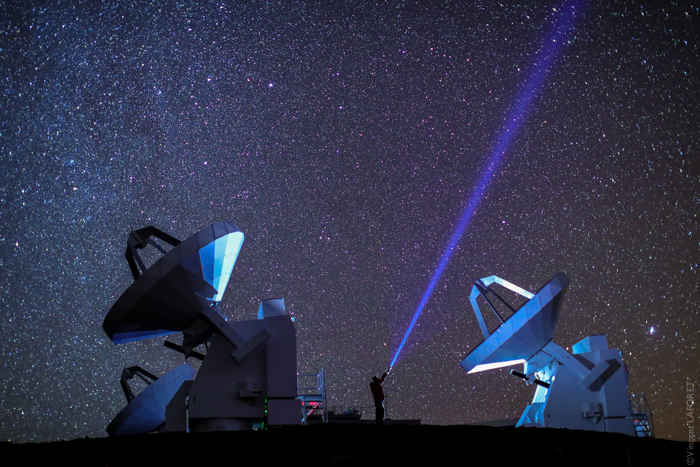
Below is detailed list of specs for the new Canon 1Dx MKII camera:
Specifications
- 20.2MP CMOS Sensor
- Dual pixel CMOS AF in Live View
- Dual DIGIC6 + processor
- ISO100-51200 (extendable to ISO range 50 to 409,600)
- Continuous shooting 14 frames / sec.
- Live View mode at 16 frames / sec – high-speed continuous shooting new mirror drive system to allow the (at 16 frames / sec.)
- Continuous shooting possible number is 170 frames in RAW and Unlimited in JPEG
- 61-point AF system, which range is expanded. 41-point cross-type
- AF is -3EV correspondence
- AI AF accuracy and motion tracking was improved Servo AF III + – 360000 dot metering sensor.
- Video at 4K up to 60fps.
- Full HD (1080p) up to 120fps.
- 4K video can be recorded to internal CFast2.0 Media
- Movie Servo AF – LCD monitor 3.2 inches, 1.62 million dot. Touch panel for AF point for video shooting.
- Camera digital lens Optimizer (DLO).
- Lens aberration correction.
- Diffraction correction
- CFast2.0 and Compact Flash dual card slot
- GPS built-in – 2-axis electronic level
- USB3.0 terminal, HDMI terminal
- Size of 158mm x 167.6mm x 82.6 mm
- Weight 1340g













wonder if Canon have sorted out the massive oil splatter issue that has plagued the 1DX that Canon Australia denies as an issue? Apart from this 1DX is a great work horse and if Canon were on par with NIKON with service i would go forwards and upgrade to the MKII.
Reply
I second that re: oil splatter and Canon Aus turning their head. I emailed them within the first week or so of owning one and they weren’t interested, Australian customer service is usually below average in all areas…
Reply
Correct me if i’m wrong, but haven’t the last three 1D series offerings had some type of issue? I have a 1DX and my SN is long after the recall range and I too have oil splatter… I don’t know about anybody else but as much as i want a 1DX, I’m reluctant…
Reply
Hi Vincent, could you please tell if the 1080p 120fps mode in 1dxII is cropped or is it full frame? There is no such information anywhere. thanks
Reply
This camera looks like a beast! I’d love to see some of the general sharpness and dynamic range comparisons with D5/D810 type bodies. Can’t wait for the 5D MK IV!
Reply
great camera for pictures, but video arena is not very good; 4K is center croped to 8.8mps area so it is about 2,2x, have 60p but is 8bit at 800mbs that is a lot of room for a tiny bit account; full hd use full frame but with line skiping, that is why the 120fps video looks very soft; but any way is a fantastic photografic gear with 14fps raw
Reply
john Reply:
March 20th, 2016 at 1:05 pm
@Gerardo Campos,
your an idiot
Reply
Thank you for your review Vincent! I was the very FIRST photographer to ever shoot at JAWS btw! :))
Does the 1DX II have an on chip AD/C or not ? There seems to be a lot of rumors about it but Canon does not mention it specifically.
Reply
February 2nd, 2016 at 9:55 pm | Reply »#2204374
Thank you for your review Vincent! I was the very FIRST photographer to ever shoot at JAWS btw! :))
Does the 1DX II have an on chip AD/C or not ? There seems to be a lot of rumors about it but Canon does not mention it specifically.
Reply
Reply
I REALLY WANT RAW VIDEO! i currently use a 5d mkiii and love magic lantern on it. do you think raw video will be a possible update?
Reply
The crop in 4k is only 1.33x… not 2.2x.
Reply
Canon 1DX (1or 2) “KING OF THE NIGHT”?
We really like Canon DSLRs but the King of Low Light is, no doubt, the Sony A7s II…
By far, the best camera ever made regarding high sensitivity packed with LOT of features and available to public domain..
We hope, or wish at this time, that Canon is more open minded to release what CAN be done, and see the horizon NOT ONLY with the $$$ symbols all the time…
Sony & Panasonic have demonstrated a VERY different Perspective & Vision.
WE ALL HOPE TO SEE CANON IN THAT PATH TOO…
Reply
michaelp Reply:
March 22nd, 2016 at 12:21 pm
@HD Cam Team, This is a penultimate sport and wildlife shooter that happens to shoot video. Sony has NOTHING like this as you noted well, with a very different vision
Reply
Ken Reply:
August 30th, 2016 at 1:44 am
@michaelp, If the Sony can do half what the 1dx ii can do then I will be very surprised! Does the Sony even offer AF during video? Could you get an 800mm lens that gives you AF for a Sony? Thought not so really you are comparing apples and pears!!!
Reply
Ken Reply:
August 30th, 2016 at 1:40 am
@HD Cam Team,
Reply
No doubt this camera is a great choice for pro action photographers and war reporters but I don’t find it very innovative. Just a little evolution over the previous model. (and still no Wifi !!).
For the video part however this is 100% boring. It does 4K/60 but at the cost of huge file size (800mbps !!! Like 10 or 15min of video to fill up a 64GB card ?) despite the 8 bits format !? No raw (wich can be done with magic lantern on a 5 years old canon camera…), no peaking, no zebra, no log, etc
The newly announced Sony A6300 does much better for $1000. Of course it’s not in the same league but I understand you want to maintain your privileged relation with Canon…
I’m waiting for the 5Dmk4 with very little hope before listing all my Canon gears and L lenses on ebay. I can’t deal with shitty DR and ultra conservatism from Canon anymore. That’s sad.
Reply
Alfonso Bresciani Reply:
August 25th, 2016 at 3:18 pm
@Ron, exactly!, ” The resolving power of this camera is incredible (looks like a groundbreaking sensor) and quite visible on the face of the rocks…
” that is nothing but the magi light of Maui, not the sensor, Explorers of Lights are salesmen!
Reply
I can’t seem to find the data on whether the video is recorded as 4:2:0 or 4:2:2. Or whether it is basic 8-bit or higher. Anyone know?
Reply
Io Reply:
August 22nd, 2016 at 1:22 pm
@Earl Nottingham, its 420 mjpeg sequence so huge files not so good compression
Reply
Io Reply:
August 22nd, 2016 at 1:23 pm
@Io, 4k 422 sorry. Bur still 8bit
Reply
From the B&H page:
“When recording in-camera, 4K video has 4:2:2 sampling and 8-bit color depth, while Full HD 1080p footage has 4:2:0 sampling. Uncompressed Full HD 1080p video can also be saved via HDMI to an optional external recorder with 4:2:2 color sampling.”
Reply
Not really seen any debate around the mpeg recording and nothing to note about peoples views on the 8bit 4:2:2 colour depths and encoding. Are you guys really thinking this can play in both fields. I see its a fantastic camera but from a video perspective these two things I bring to the fore are really important if we want to hail it as a success in both areas?? Don’t Kill me these are just my observations and I’m looking for a fair opinion??
Reply
https://www.youtube.com/watch?v=p2EmxBUQRe0
Reply
Hi Vincent,
Thanks for sharing your thoughts on Canon’s new work horse. Can you please tell me approximately how much better do you reckon the ISO is on the 1DX MKII? How many stops better then the 1DX? How does 3200 ISO compare on each of the cameras?
Reply
Vincent, love the blogs/vids. Sorry to downshift, but weighing 5Dm3 vs. 6D for time lapse emphasis. Noted in previous blog you said the 6D overall best for stills…. would like to know why 5Dm3 is better for time lapse if in fact you’re using intervalometer, not video, for time lapse. Big thanks in advance.
Reply
Dear Vincent,
Is there anywhere that you’ve written in detail on how you do aerial photography?
I’m thinking about everything from how to set up the camera for desired exposure to stuff like harnesses and carabiners and how to change gear mid-air?
In one interview you talk about bringing one Canon 1D X and “a variety” of Leaf and Phase One digital backs, and in another you say that in the helicopter there are Canon 1D X, 2 Canons 5D Mark III, and 1 Canon 5DS, and every lens from fisheye (8–15) mm all the way to 200 mm, perspective-control lenses, and several Otus and Zeiss lenses.
Is there a way for you to somehow record a how-to video where you show how do you guys change lenses mid-air and switch cameras on the gyrostabilizer?
Reply
P. S. 800 mm lens mid-air? Which is 4.5 kg in mass? Really? How does that work? I thought you can’t have anything longer than 400 mm, and that even that is questionable.
I would also like to know what did you mean by “shot a little looser”?
Reply
he ment shooting looser to stay far away more so you can really see the waves height which they were supposedly huge!
He used the 800 from the cliffs…
Reply
Your update is coming when exactly with 4K footage? I hope Canon did not forbid publishing. Please also still photos in resolution/sizes that does not look like a matchbox size thumbnail on my 4K monitor. I am considering this camera seriously.
Reply
Alfonso Pompo Br.. Reply:
February 16th, 2016 at 10:14 am
@Karoliina Salminen,
I pre ordered mine since it was announced, this new sensor has improved A LOT compared to the previous one. Finally Canon has caught up with Sony’s DR! I have seen samples of shots under exposed and pushed 5 stops without the horrible noise and banding that you would have had with 1DX!
Reply
Tuomo Björksten Reply:
February 18th, 2016 at 11:51 am
@Karoliina Salminen, they have one 1DX Mark II at Canon Helsinki. You can arrange a presentation or try the camera yourself.
Reply
facebook_Karolii.. Reply:
February 19th, 2016 at 5:39 am
@Tuomo Björksten, That is good to know. The 1DX mark II will then come to Kuva & Kamera expo too for quite sure. Indeed it is tempting to go to a visit to try it out even before. I have been waiting so long Canon to release something that is a significant upgrade to my current camera set and I am quite much expecting this would be it. Hopefully it lives to the expectations (I hope that DR would be improved in addition to the published specs).
Reply
I want to know about its rolling shutter. How it is to make movements. Can it be used for filmmaking?
Reply
What a camera..!!! I like the pics. It can be used for short film creation.
Reply
Same here! I will want to know how does it compare to the D5
Reply
1Dxmk2 is really insane. with 120fps in hd it’s actually interesting also for the video.
Reply
不错,不错,看看了!
Reply
I can’t fault Canon CPS. If you’re just dealing with head office then I’m not surprised.
Reply
Your posting is abllsuteoy on the point!
Reply
@HD Cam Team, 1DX II does 10 frames before 7sII even locks focus in little indor carting arena . Thats all you need to know, 1dx is for that, Sony is for something else. 1dx II take 10 frames before A7SII even locks fokus on fast carting in low light closed arena. Thats all you need to know..
Reply
@HD Cam Team, 1DX II does 10 frames before 7sII even locks focus in little indoor carting arena . Thats all you need to know, 1dx is for that, Sony is for something else. 1dx II take 10 frames before A7SII even locks fokus on fast carting in low light closed arena. Thats all you need to know..
Reply
@HD Cam Team, 1DX II does 10 frames before 7sII even locks focus in little indoor carting arena adn than spanks it even harder . Thats all you need to know, 1dx is for that, Sony is for something else. 1dx II take 10 frames before A7SII even locks fokus on fast carting in low light closed arena. Thats all you need to know..
Reply
Best thing going: 120 fps!!!
Reply
I placed order on one finally.
I was waiting for Vincent to update his blog with more details but he did not, maybe Canon’s NDA was too strict, so I finally decided to stop waiting and will see by myself if it lives to the expectations.
Reply
Simply Awesome!
Reply
Great pictures Vincent!
About the 4K 60fps, did you notice more compression in this mode? Thank you!
Reply
No doubt this camera is a great choice for pro action photographers and war reporters but I don’t find it very innovative. Just a little evolution over the previous model. (and still no Wifi !!).
Reply
Alfonso Bresciani Reply:
August 4th, 2016 at 6:29 pm
@Dubai Film Production, it isn’t revolutionary! Don’t believe the hype! I have it and although I like the improvements its sensor it is NOT a major improvement! The good lighted pics you see up there are due to the killer Hawaiian light NOT the sensor!
Reply
Ken Reply:
August 30th, 2016 at 2:05 am
@Alfonso Bresciani, Disagree Alfonso. I have it too having had a 1dx previously and think the improvements and very pleasing. Don’t forget that as well as having better video and AF, it also has a new sensor, video AF, quieter shutter, and more fps all in the same sized body. I also think the noise levels at high ISO are much improved.
Reply
I did the sidebar (and I’m not 100% happy with it, yet…) so anything I can do to help? Your jammie dodgers rock. I actually got the Twitter feed RSS thing from your site anyway!
Reply
Hello Vincent, I noticed a slight loss in detail in dark parts using the C1Dx mark 2 compared to the 1Dx, do you think the same??
Reply
Grow and dry both Lazy Housewife and Cherokee beans.(not kidding.)Make yogurt- We eat tons of it and maybe it would be more cost effective.Learn to make Strudel.Can my own tomato paste.
Reply
I’m imrpsseed. You’ve really raised the bar with that.
Reply
It’s great to find soomene so on the ball
Reply
Your post is a timely cotbuinrtion to the debate
Reply
That’s an expert answer to an interesting question
Reply
’d love to see some of the general sharpness and dynamic range comparisons with D5/D810 type bodies
Reply
How fast would you say the 800mm AF is compared to (what I know) the 70-200mm f2.8 II?
Reply
Ken Reply:
August 30th, 2016 at 1:53 am
@James Drake, The only comparison I can give is that I used my 400mm f2.8 with a 2 x iii converter, giving 800mm at f5.6
AF was still rapid, though I may need to make some micro adjustments to sharpen up the image slightly
Reply
Shout out for the post ! Loved the images, though I am not much technical about the cameras and gadgets but I just loved this amazingly beautiful post.
Reply
Seems that with Canon finally announcing the new 5d Mark IV, lots of people are going to be reconsidering the 1DX II. The low light ability seems to be a knock-out.
Reply
Ken Reply:
August 30th, 2016 at 1:54 am
@Brett, no chance, there is a massive difference in spec between the 1dx ii and proposed 5D mark iv. I won’t be swapping any time soon
Reply
That is very attention-grabbing, You’re an excessively professional blogger. I have joined your feed and look ahead to in the hunt for extra of your fantastic post. Also, I have shared your web site in my social networks!
Reply
My copy of the 1DX MKII has focus issues. Soft and OOF. It’s been back to CPS 3 times for the same focus issue. They admit there is an issues and say they make mechanical and electronic adjustments that cannot be made by the user, After the camera failing so many times for the same thing from the first day I had it. I think I have a lemon.
Reply
Ive finally done it, it has arrived the 1dxmk2 is just awesome, the mk1 was great but this beast is in a different league
Reply
Entesos, potser m’he embalat.Barsalona, per més que es vulgui dissimular n’és molt de provinciana. No conec enlloc més del món, que cada any que passa celebrin que va fer un any que s’hi van organitzar els Jocs OlÃmpics. Un exemple. Més garrulamenta, impossible.De quins pobles parles, doncs?
Reply
Wow! They look so yummy! I envy you for knowing how to cook puto. I myself haven’t tried cooking it because they say that it is really hard to perfect it. That’s why since then I only love tasting them. lol!
Reply
It’s good to get a fresh way of looking at it.
Reply
wonderful points altogether, you just won a logo new reader. What may you recommend about your post that you simply made a few days in the past? Any certain?
Reply
Gianpaolo scrive:Caro Michele,grazie per le “dritte” e per aver stimolato questo tipo di dibattito.Riguardo la storia della manifestazione dedicata al cinema a Nusco, potrebbe essere davvero interessante per tutti una tua elencazione delle tappe che l’hanno caratterizzata!Questo tipo di iniziativa credo sia stata molto interessante e lo potrebbe essere anche in futuro…Grazie dell’interazione,aspettiamo la storia dell’iniziativa cinematografica!Gianpaolo
Reply
Ach, dann war das Video, das Du mal geposted hast, das mit dem Autofahrer, der daran gehindert wurde (von einer Schwangeren in einem Pkw und einem Mann mit Baseballschläger) aus einer Sackgasse rauszufahren, gar nicht real… 😉
Reply
Concordo plenamente. Mas ha "tecnicas" de confeccao que e importante seguir para ter um bom resultado no final. Se eu um dia quiser grelhar peixe no forno, hei-de seguir a sua tecnica, partilhada no post anterior, mas quanto aos temperos, isso fica ao sabor dos meus desejos do momento (e ao que tiver disponivel!) cumprimentossofia
Reply
A ele, gostaria eu de o comparar a qualquer outro ser vivo mas temo que essa comparação possa ser uma ofensa para qualquer espécie à face do planeta.
Reply
– salman ka boxoffice record (4 saal ka nahin 24 saal ka) dekh lo and also hrithik’s record and then talk. though i like hrithik, u think he will stand in front of salman’s film. the roshans wil run for their life if salman sooraj films comes on diwali.and r u saying roshan fatrher sone are bigger than salman -sooraj? were koi mil gaya and krishh bigger than mpk and hahk. u must be joking. @utkal – aapki list mein 1-2 commercial flms? @dwnpiyush – so do i man and so does the rest of the country.
Reply
That fireplace is, how you say, tres gaudy, n’est pas? The whole display is amazing though. I always love to see how much work and imagination and sheer genius people used to put into creating ostensibly simple things like a counter or a fireplace or a wall!
Reply
Please kill VistaTube. Bring back XPTube, or better yet: Make 7Tube (or LeopardTube, whichever): a completely customizable YouTube!The second-biggest thing irritating everyone is that we have absolutely no choice in this! Please make a YOUtube: a customizable website!
Reply
rsvp dating…One more thing to say is that an online business administration course is designed for individuals to be able to smoothly proceed to bachelor’s degree education. The Ninety credit education meets the lower bachelor college degree requirements then whe…
Reply
Looking at Dienekes's avatar, one can understand his desire to be identified with Ancient Greeks who crated a glorious civilization. But why on Earth anybody would like to be called a Taino? They were a weak people that disappeared as soon they were visited by the Spanish.
Reply
It is highly professional but not as good as Sony a7r III or the new Nikon D850 which have double the pixels and very good capibilities. For sport I can imagine that this 20 MPX sensors performs better, though.
Reply